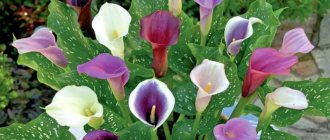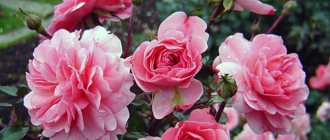The author of the variety is Boris Mikhailovich Makuni . He is rightfully considered one of the founders of Russian violet selection.
He worked together with his wife Tatyana Nikolaevna. Since the middle of the last century, the creative tandem has developed more than 300 different varieties of Saintpaulia.
The varieties of the Makuni spouses
made a splash at exhibitions in the USA and Japan. In addition to practical work on crossing and growing violets, Makuni devoted a lot of work to writing articles and books on care and propagation. Makuni are the founders of the Russian school of breeding Uzambara violets. Many talented Russian breeders studied with them.
Violet Magic Night (B. Makuni)
Violet Magic Night.
Systematic position
Order : Clear-flowered (Lamiáles).
Family : Gesneriaceae.
Genus : Hybrid Saintpaulia (Saintpaulia hybrida).
Photo and description of the variety
The Saintpaulia variety Magic Night is characterized by double dark blue flowers strewn with pink specks.
Sometimes the spots are snow-white. The flowers are small, but there are a lot of them in each bloom.
Saintpaulia leaves:
- Rich green color;
- Velvet;
- With serrated edge;
- Standard.
The rosette is quite large and dense.
Creator of varieties
Both varieties presented, which stand out brilliantly in any home collection, were registered in the lists of AVSA - the American Violet Society.
This was done by an active popularizer of Saintpaulia and a wonderful Texas breeder, whose name is in the AVSA Hall of Fame, Hortense Pittman, as a result of completing the next series of experiments in the field of breeding exotic beauties.
Hortense Pittman's passion for violets began around the mid-twentieth century (late 60s) thanks to a single specimen of Saintpaulia given to her as a gift.
The florist's collecting of violets gradually grew into an interest in their selection.
1979 was marked by the appearance of her own varietal specimen, which was largely facilitated by assistance in comprehending the wisdom of breeding from Harold Utz, a friend of the Pittman couple, who was actively involved in breeding tropical beauties at that time.
Hortense, together with her husband Ray Pittman, creates a family nursery of Uzambara violets “Hortense's African Violet” , constantly takes part in exhibitions, leads the main American society of violet lovers as the 27th president and constantly works to improve the qualities and images of Saintpaulia.
The results of her work are marked by the creation of more than 670 different varieties from several branded lines. Miniature species are especially loved by the master.
IMPORTANT! The violets presented are examples from the most significant line of G. Pittman with the abbreviation “Jolly”.
Home care
Proper watering and fertilizing
The Magic Night variety loves watering. When the substrate dries out, it quickly drops its leaves and flower stalks. The frequency of watering depends on many factors :
- Light intensity;
- Air temperature and humidity;
- Age and life stage of the violet;
- The material from which the pot is made, and much more.
Many violets prefer watering from above.
It must be remembered that the size of the intervals between waterings is important , and not the volume of water poured. The violet needs to be watered when the top layer of the substrate has dried, and this happens in different plants at different intervals.
Water the violets with soft, settled water at a temperature of 23-25 degrees.
It is preferable to water Saintpaulia from above, using :
- Syringes with a volume of 150-200 ml;
- Or a small watering can with a long spout.
Important! Liquid fertilizers are optimal for violets. This type of fertilizer is easier to dose.
These devices will provide a thin stream of water and protect the leaves from moisture and the soil from erosion.
Occasionally, you can water the violets by immersing them 1/3 of the height of the pot in water, but it is better not to abuse this method , since with such watering there is a high risk of root rotting.
Basic rules for feeding violets:
- Young plants need nitrogen;
- Phosphorus stimulates the formation of a large number of buds;
- During flowering, plants need potassium;
- We introduce fertilizing from above, with water for irrigation;
- The optimal choice is a complex fertilizer containing chelated forms of the main macro and microelements;
- Often, instead of fertilizers, transshipment will be more beneficial for the plant.
Lighting and temperature
The brighter the room, the brighter, larger the flowers and the greater their number.
Important! Avoid direct sunlight! They cause burns on leaves and flowers. Choose northern or northeastern, northwestern window sills for violets to live.
In winter, violets require additional lighting.
The temperature in the room where violets live should be about 20-220 . Children and cuttings need a temperature of 24-250 and higher humidity. Temperatures that drop below +130 and rise to +290 can seriously harm the violet.
Effect of air humidity
Saintpaulias in their natural environment prefer river banks and the surroundings of waterfalls; moisture in the air is very important for them .
A humidity level of 60-70% will be favorable. With regular watering and a comfortable temperature, adult plants feel good even at lower humidity (30-40%).
In winter, in conditions of air dried by radiators, the humidity level is maintained artificially . You can use a humidifier or improvised means.
Soil requirements
The soil must have the following properties :
- Ease;
- Air permeability;
- Moisture capacity;
- Sufficient amount of macro and microelements;
- pH 5.5-6.5 (slightly acidic);
- Absence of pathogens and pests;
- The presence of living beneficial microflora.
Important! Most store-bought potting mixes are not suitable for violets. Black mixtures made from lowland peat are especially dangerous.
Soil for violets can be bought at a flower shop.
An example of the composition of a mixture for planting Saintpaulia:
- High-moor peat and Greenword soil – 5 parts;
- Vermiculite (perlite) – 2 parts;
- Sphagnum (coconut fiber) – 2 parts;
- Nutritious soil – 1 part;
- Adding crushed charcoal and dolomite flour will further improve the quality of the mixture.
This recipe can serve as a starting point for your experiments. The main thing is that the finished mixture is light and does not cake.
Pruning and hygiene
In order for the grown rosette of Saintpaulia to be beautiful and neat, it is subjected to shaping . Usually the top three tiers of leaves are left. Lower leaves can be removed. Removed:
- Peduncles with wilted flowers;
- Yellowed, diseased, damaged leaves.
By removing the lower leaves, we gradually open the violet stem. is sprinkled with fresh soil as necessary .
Give the violets in your collection a weekly inspection. Each pot is picked up, the outlet is inspected, checking the need :
- Glaze;
- Adding substrate;
- Removing leaves and flower stalks
Also, when examining, pay attention to the following signs :
- Parasites (cobwebs, wilting);
- And diseases (wet areas, spots).
Inspect violets for pests and diseases.
Dust, accumulating in the fleecy leaves of violets, harms the plant. It is washed off under the tap , protecting the soil with a bag, tying it on the pot so that water does not fall on the soil.
Attention! Each leaf is washed separately under a thin stream of warm water.
Reproduction methods
The best results are obtained by vegetative propagation by rooting leaves .
Transplant rules, rejuvenation
to replant violets of the Magic Night variety in the following cases:
- Violet grows in this substrate for 2 or more years;
- Roots appeared from the drainage hole;
- The plant withers, although watering is optimal;
- The soil in the pot has become sour;
- You have decided to rejuvenate or deepen the plant.
We carry out all manipulations during transplantation carefully. Violets are delicate creatures .
Transfer procedure:
- Remove the root ball from the pot. (It is better if the substrate is dried);
- Remove most of the old soil;
- Trim off excessively long roots, as well as old, damaged roots;
- Place the violet in the new substrate;
- After 24 hours, water the plant and, if necessary, add soil.
Important! The pot size remains the same!
The magical night, which has reached the age of 2.5-3 years, needs to be rejuvenated . If you leave the plant for a longer period, you will not see cap flowering. To rejuvenate the plant, the “head” (the growing point and 2 tiers of leaves) is cut off and rooted in a greenhouse.
The old violet needs to be rejuvenated.
Organization of additional lighting
To properly organize artificial lighting, pots of violets are placed on shelves or racks.
Types of lamps
Conventional incandescent lamps are not suitable for growing violets:
- they have an inappropriate emission spectrum;
- low efficiency;
- emit a lot of heat, which is harmful to the flower.
Illumination with incandescent lamps is unacceptable, because they may cause burns.
The lighting source is usually linear fluorescent lamps , which come in white, cool white and warm white spectrums. They are made in the form of tubes with a diameter of 26 mm and differ in length, which correlates with power:
- a lamp 60 cm long corresponds to a power of 18 W;
- 90 cm long - 30 W;
- length 120 cm - 36 W;
- length 150 cm - 54 W.
The size of the lamp and its power are selected based on the area of the illuminated area. When choosing a lamp, you need to consider that:
- the shorter the lamp, the less it will last (the service life of an 18 W lamp is about six months, and a 36 W lamp is almost a year). After this period, the luminous flux weakens, although this is not visually noticeable;
- The luminous flux produced by two 18 W lamps is less intense than from one 36 W lamp.
Fluorescent lamps are filled with a small amount of mercury. As long as the lamp is intact, its use is completely safe.
Carefully! A broken fluorescent lamp is dangerous to your health; it is disposed of at special points.
are also effective . Their main advantage compared to other lamps:
- high energy efficiency;
- Easy to attach to any surface and in any position.
The downside is the fairly high cost.
Distance to outlet leaves, maximum number of hours of switching on per day
Lamps are fixed on shelves according to certain rules:
- the interval between the shelves is determined by the distance from the light source to the leaves of the flower;
- shelves for standard varieties of violets are placed at intervals of 40-50 cm, while the distance of the lamp from the bush should be 30-35 cm;
- for mini-varieties of violets, maintain an interval between shelves of 25-30 cm.
Organization of lighting at standard shelf heights.
In this case, it is necessary to take into account the height of the pot and the design of the lamp . For example, with a height of pots of 10 - 12 cm and a lamp thickness of 7 cm, the gap between the shelves is about 45 cm. When installing LED strips, the distance between the shelves will be much smaller - about 25 cm.
The most comfortable light mode for violets is 12 hours of light, 12 hours of darkness . If the plants show that there is not enough light, the lighting period can be increased to 15 hours a day. If this does not help, you will have to change the design of the rack: reduce the gap between the lamp and the flower, or hang another lamp.
Lamp power calculation
When planning shelves for violets, you should focus on the dimensions of a standard lamp:
- for shelves 70 cm long, 18 W lamps are installed;
- for 130 cm shelves - 36 W lamps.
The number of lamps also correlates with the width of the shelves:
- one lamp provides the necessary illumination for a shelf about 30 cm wide;
- two lamps - shelves 50 cm wide.
When calculating lighting for violets, you need to consider that:
- per 1 cm2 of shelf area, the light flux from fluorescent lamps should be 0.7-0.9 Lumens;
- per 1 cm2 of shelf area, the light flux from LED lamps or strip should be 0.22-0.44 Lumens.
Based on this, a shelf measuring 96x38 cm (area 3650 cm2) needs to provide light flow:
- produced by fluorescent lamps - 2550-3280 Lumens;
- produced by LEDs (lamp or strip) - 800-1600 Lumens.
The optimal light flow is the one that is closest to the maximum (1300 - 1700 Lumens per shelf). For example, for a shelf 100x38 cm, the luminous flux should be 840-1680 Lumens.
Advice! The temperature on the upper shelves is always slightly higher than on the lower ones, so it is better to place young plants on them.
Features of flowering, growth and reproduction
Magic Night grows well on a shelf, but still prefers a window .
How long does it take to grow an adult plant?
, 10-12 months will pass between the rooting of the baby and the first buds . When growing this variety from cuttings, you will need to wait 2-3 weeks longer.
Reproduction methods and features
are transmitted very well during vegetative propagation .
The procedure for propagating violets by leaf cuttings is known to everyone from a school biology textbook:
- For rooting you need a small glass (80 ml) with drainage;
- We cut or carefully break off a healthy leaf from the second tier;
- We root the cuttings into the soil with the addition of cultivators (perlite, vermiculite);
- Cover with another glass or put in a bag;
- We are expecting the baby to arrive in a couple of weeks.
Leaf cuttings can be rooted in boiled water and then transplanted into soil .
Features of flowering in hot and cool conditions
Temperature conditions do not affect the flowering of the variety.
What do flower stalks look like?
Peduncles are quite strong and dark-colored. When flowering they do not fall, they firmly bear the weight of the flowers .
The peduncles of violets are very strong.
Is it possible to achieve cap flowering?
The variety Magic Night has cap flowering . The cap is formed by voluminous double flowers and due to the large number of peduncles.
Bud lifespan
Each flower then fades approximately 6-8 days after the bud opens.
Is it possible to grow completely under artificial light?
In artificial lighting conditions, violets grow and develop well , thanks to this:
- Saintpaulia can be propagated by leaves all year round;
- place large collections regardless of the location of windows and shelf space.
When installing artificial lighting, it must be taken into account that the process of photosynthesis requires blue and red spectrum.
apply to artificial lighting of violets :
- During the period of formation of peduncles, the duration of illumination is increased from 10 to 12-14 hours, or the light intensity is increased, including not one, but several lamps, or the violet is raised closer to the lamp;
- In order not to cause leaf burn, the length of daylight is increased gradually, adding 30 minutes every two days;
- The timing of turning on the lamps is important for plants: it is preferable to do this at the same time every day.
To regulate lighting, use a mechanical or electronic timer that turns on and off at the right time.
Reviews
Violet receives a lot of positive feedback from gardeners.
Veronica. “For me, the fantastic violet “RM-Royal Lace” is the most ideal indoor plant. With care and proper care, Saintpaulia can bloom for a long time with lush, exotic lace, filling my soul with joy, beauty and unreal light.”











